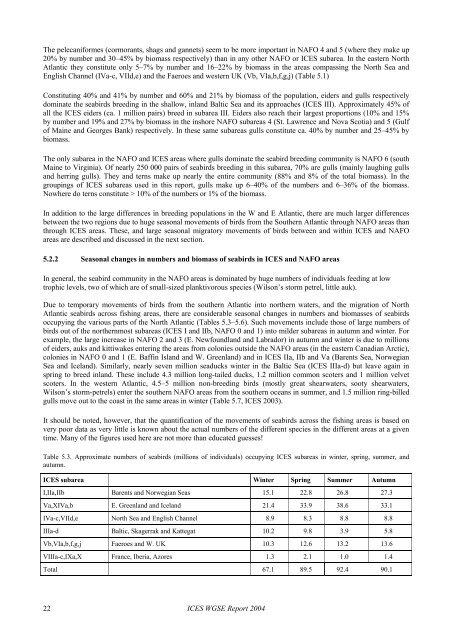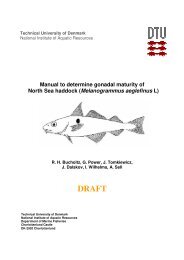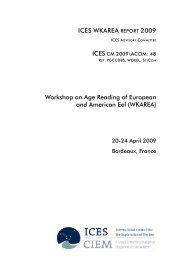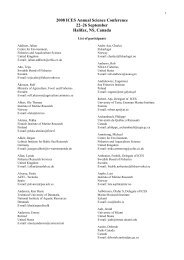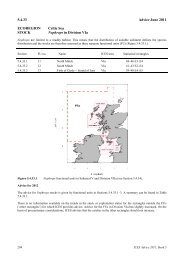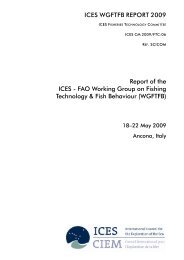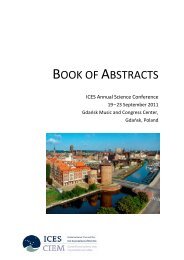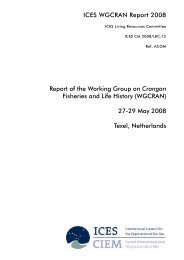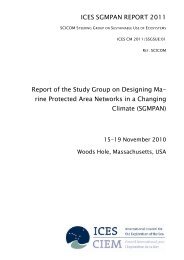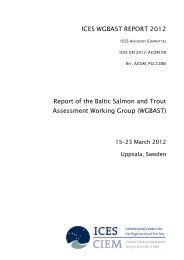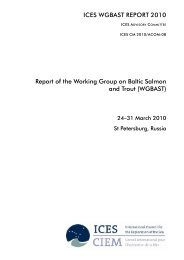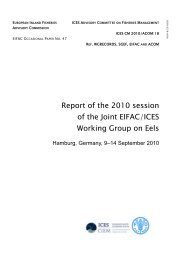Working Group on Seabird Ecology (WGSE). ICES CM 2004/C:05 ...
Working Group on Seabird Ecology (WGSE). ICES CM 2004/C:05 ...
Working Group on Seabird Ecology (WGSE). ICES CM 2004/C:05 ...
- TAGS
- seabird
- ecology
- ices
- www.ices.dk
You also want an ePaper? Increase the reach of your titles
YUMPU automatically turns print PDFs into web optimized ePapers that Google loves.
The pelecaniformes (cormorants, shags and gannets) seem to be more important in NAFO 4 and 5 (where they make up<br />
20% by number and 30–45% by biomass respectively) than in any other NAFO or <strong>ICES</strong> subarea. In the eastern North<br />
Atlantic they c<strong>on</strong>stitute <strong>on</strong>ly 5–7% by number and 16–22% by biomass in the areas compassing the North Sea and<br />
English Channel (IVa-c, VIId,e) and the Faeroes and western UK (Vb, VIa,b,f,g,j) (Table 5.1)<br />
C<strong>on</strong>stituting 40% and 41% by number and 60% and 21% by biomass of the populati<strong>on</strong>, eiders and gulls respectively<br />
dominate the seabirds breeding in the shallow, inland Baltic Sea and its approaches (<strong>ICES</strong> III). Approximately 45% of<br />
all the <strong>ICES</strong> eiders (ca. 1 milli<strong>on</strong> pairs) breed in subarea III. Eiders also reach their largest proporti<strong>on</strong>s (10% and 15%<br />
by number and 19% and 27% by biomass in the inshore NAFO subareas 4 (St. Lawrence and Nova Scotia) and 5 (Gulf<br />
of Maine and Georges Bank) respectively. In these same subareas gulls c<strong>on</strong>stitute ca. 40% by number and 25–45% by<br />
biomass.<br />
The <strong>on</strong>ly subarea in the NAFO and <strong>ICES</strong> areas where gulls dominate the seabird breeding community is NAFO 6 (south<br />
Maine to Virginia). Of nearly 250 000 pairs of seabirds breeding in this subarea, 70% are gulls (mainly laughing gulls<br />
and herring gulls). They and terns make up nearly the entire community (88% and 8% of the total biomass). In the<br />
groupings of <strong>ICES</strong> subareas used in this report, gulls make up 6–40% of the numbers and 6–36% of the biomass.<br />
Nowhere do terns c<strong>on</strong>stitute > 10% of the numbers or 1% of the biomass.<br />
In additi<strong>on</strong> to the large differences in breeding populati<strong>on</strong>s in the W and E Atlantic, there are much larger differences<br />
between the two regi<strong>on</strong>s due to huge seas<strong>on</strong>al movements of birds from the Southern Atlantic through NAFO areas than<br />
through <strong>ICES</strong> areas. These, and large seas<strong>on</strong>al migratory movements of birds between and within <strong>ICES</strong> and NAFO<br />
areas are described and discussed in the next secti<strong>on</strong>.<br />
5.2.2 Seas<strong>on</strong>al changes in numbers and biomass of seabirds in <strong>ICES</strong> and NAFO areas<br />
In general, the seabird community in the NAFO areas is dominated by huge numbers of individuals feeding at low<br />
trophic levels, two of which are of small-sized planktivorous species (Wils<strong>on</strong>’s storm petrel, little auk).<br />
Due to temporary movements of birds from the southern Atlantic into northern waters, and the migrati<strong>on</strong> of North<br />
Atlantic seabirds across fishing areas, there are c<strong>on</strong>siderable seas<strong>on</strong>al changes in numbers and biomasses of seabirds<br />
occupying the various parts of the North Atlantic (Tables 5.3–5.6). Such movements include those of large numbers of<br />
birds out of the northernmost subareas (<strong>ICES</strong> I and IIb, NAFO 0 and 1) into milder subareas in autumn and winter. For<br />
example, the large increase in NAFO 2 and 3 (E. Newfoundland and Labrador) in autumn and winter is due to milli<strong>on</strong>s<br />
of eiders, auks and kittiwakes entering the areas from col<strong>on</strong>ies outside the NAFO areas (in the eastern Canadian Arctic),<br />
col<strong>on</strong>ies in NAFO 0 and 1 (E. Baffin Island and W. Greenland) and in <strong>ICES</strong> IIa, IIb and Va (Barents Sea, Norwegian<br />
Sea and Iceland). Similarly, nearly seven milli<strong>on</strong> seaducks winter in the Baltic Sea (<strong>ICES</strong> IIIa-d) but leave again in<br />
spring to breed inland. These include 4.3 milli<strong>on</strong> l<strong>on</strong>g-tailed ducks, 1.2 milli<strong>on</strong> comm<strong>on</strong> scoters and 1 milli<strong>on</strong> velvet<br />
scoters. In the western Atlantic, 4.5–5 milli<strong>on</strong> n<strong>on</strong>-breeding birds (mostly great shearwaters, sooty shearwaters,<br />
Wils<strong>on</strong>’s storm-petrels) enter the southern NAFO areas from the southern oceans in summer, and 1.5 milli<strong>on</strong> ring-billed<br />
gulls move out to the coast in the same areas in winter (Table 5.7, <strong>ICES</strong> 2003).<br />
It should be noted, however, that the quantificati<strong>on</strong> of the movements of seabirds across the fishing areas is based <strong>on</strong><br />
very poor data as very little is known about the actual numbers of the different species in the different areas at a given<br />
time. Many of the figures used here are not more than educated guesses!<br />
Table 5.3. Approximate numbers of seabirds (milli<strong>on</strong>s of individuals) occupying <strong>ICES</strong> subareas in winter, spring, summer, and<br />
autumn.<br />
<strong>ICES</strong> subarea Winter Spring Summer Autumn<br />
I,IIa,IIb Barents and Norwegian Seas 15.1 22.8 26.8 27.3<br />
Va,XIVa,b E. Greenland and Iceland 21.4 33.9 38.6 33.1<br />
IVa-c,VIId,e North Sea and English Channel 8.9 8.3 8.8 8.8<br />
IIIa-d Baltic, Skagerrak and Kattegat 10.2 9.8 3.9 5.8<br />
Vb,VIa,b,f,g,j Faeroes and W. UK 10.3 12.6 13.2 13.6<br />
VIIIa-c,IXa,X France, Iberia, Azores 1.3 2.1 1.0 1.4<br />
Total 67.1 89.5 92.4 90.1<br />
22<br />
<strong>ICES</strong> <strong>WGSE</strong> Report <strong>2004</strong>


